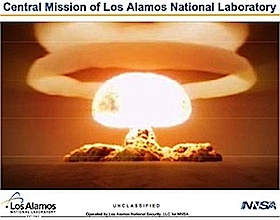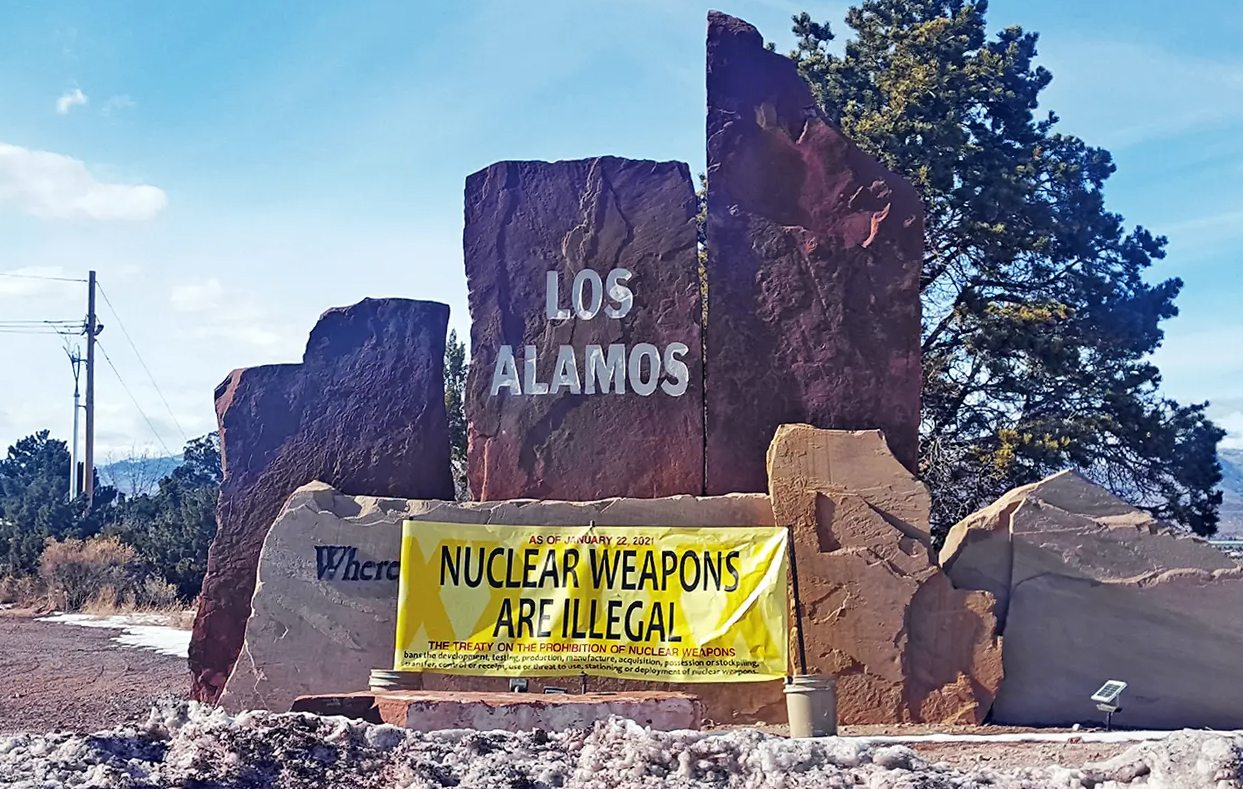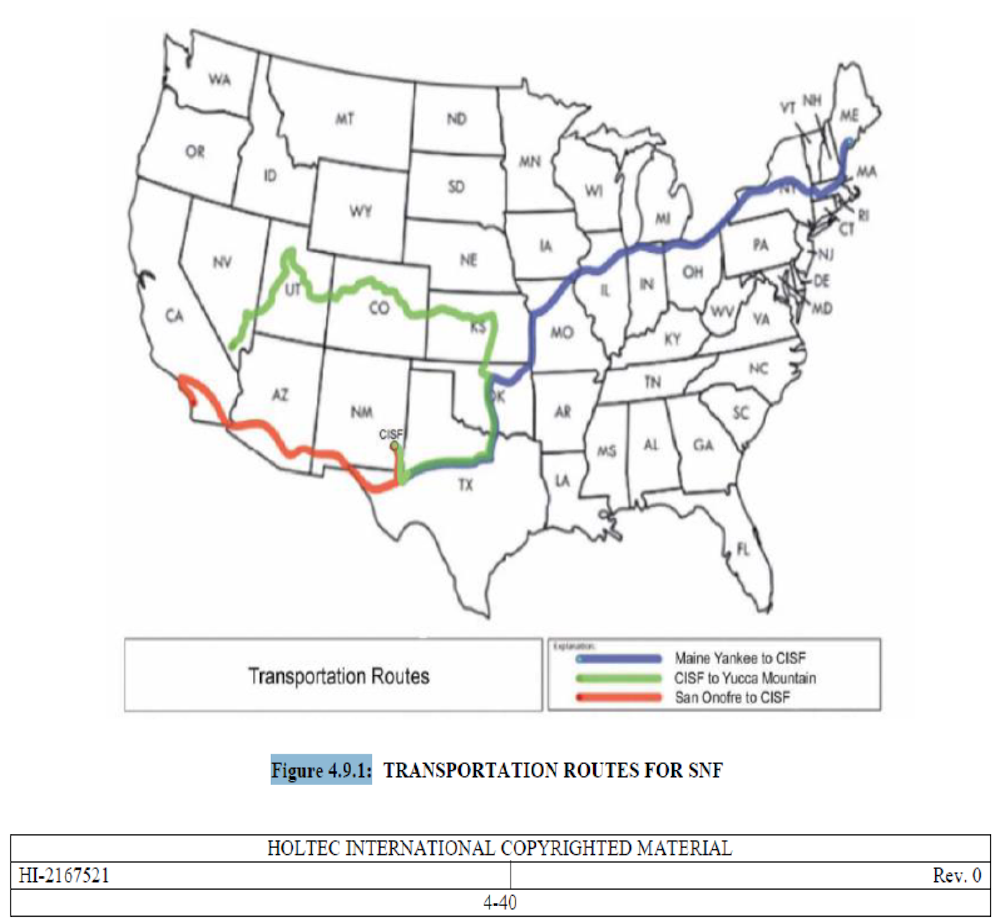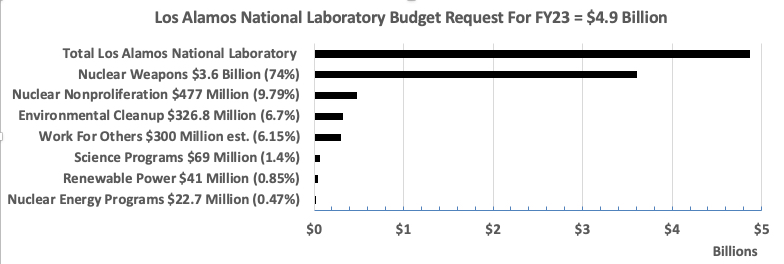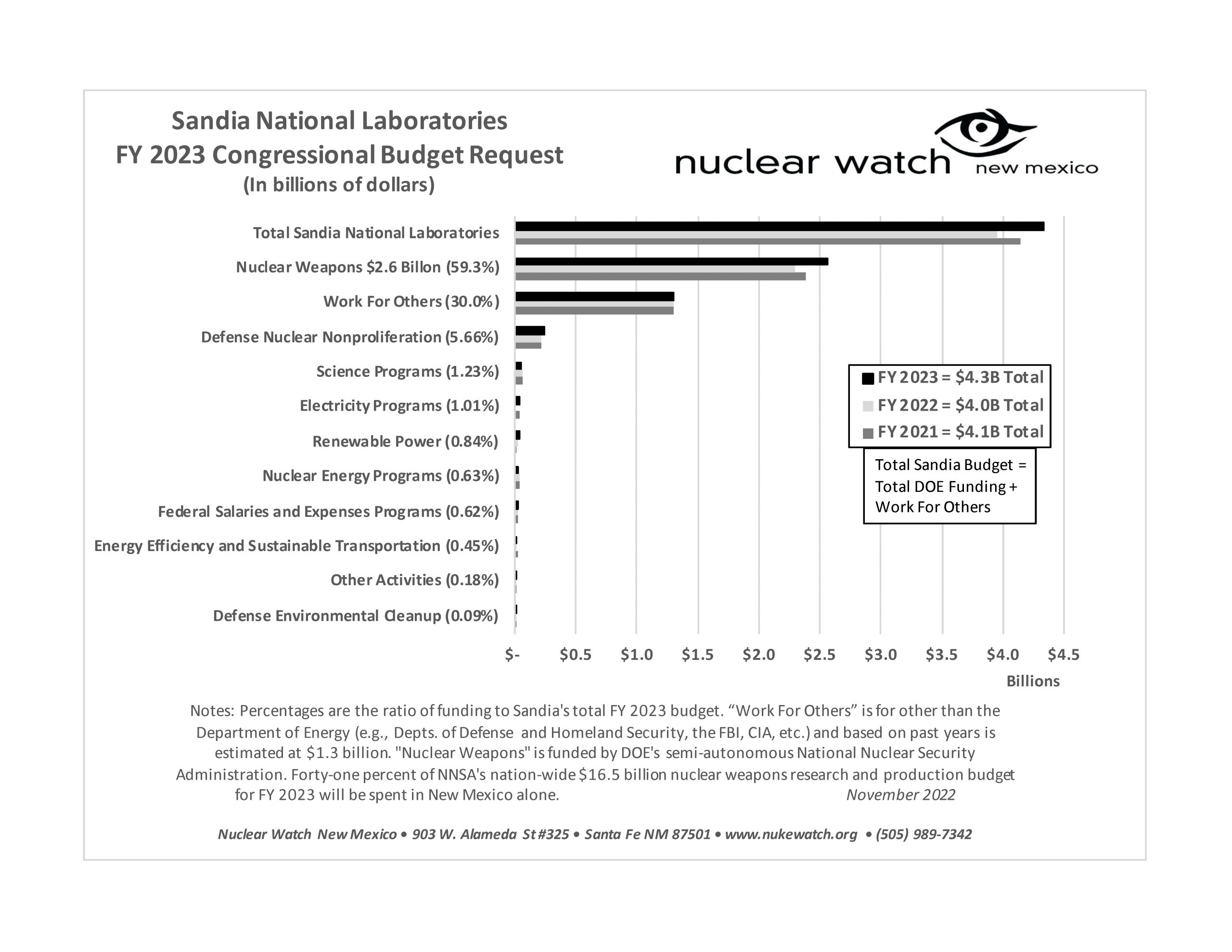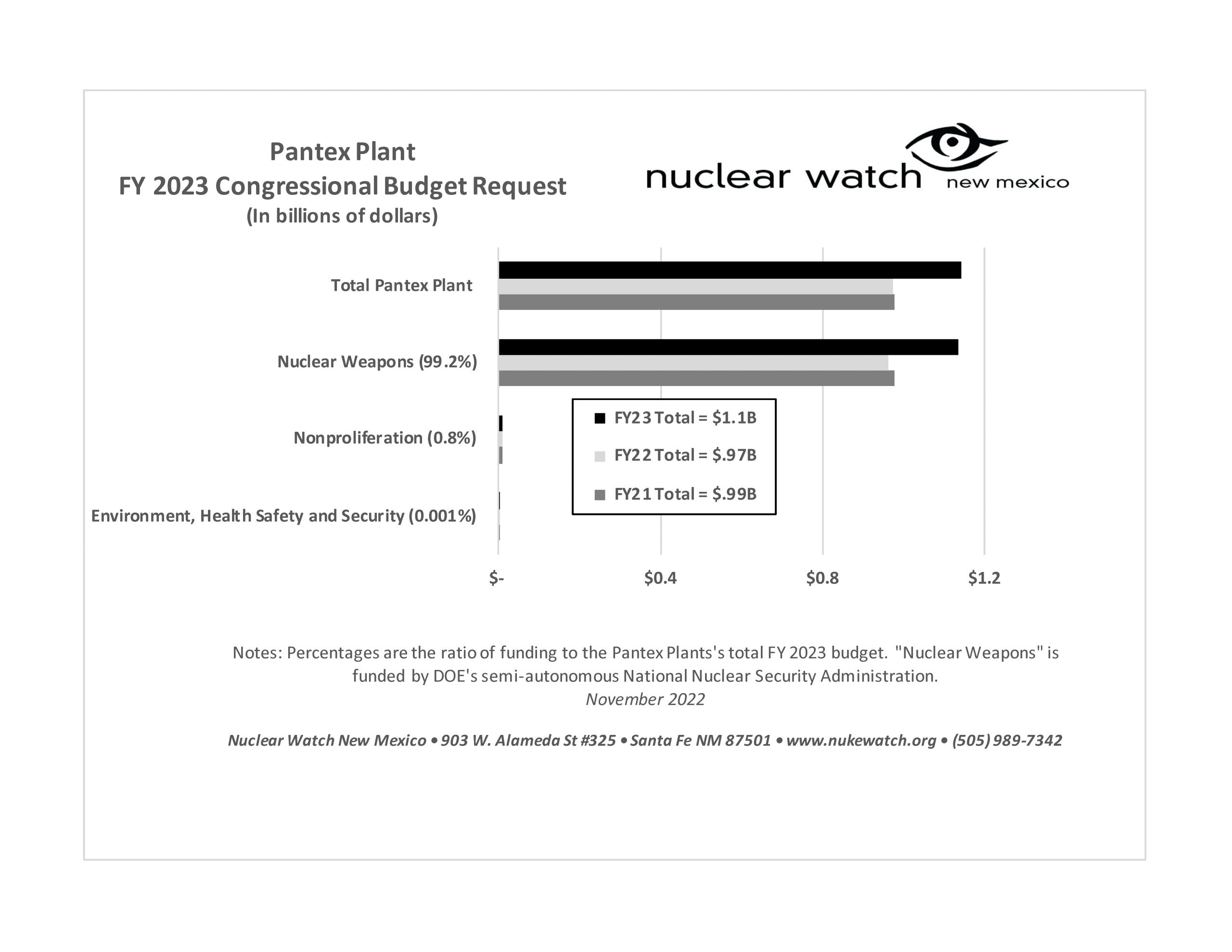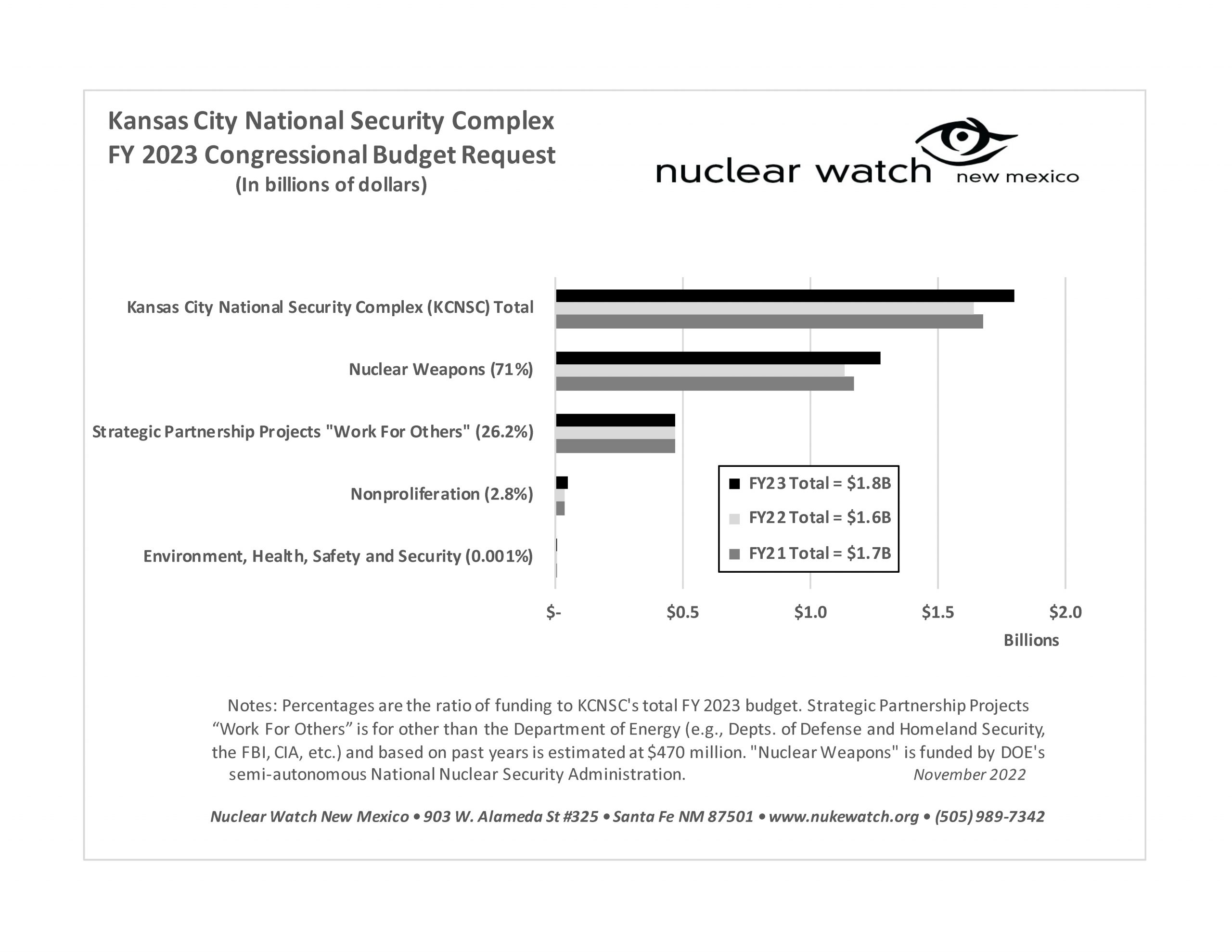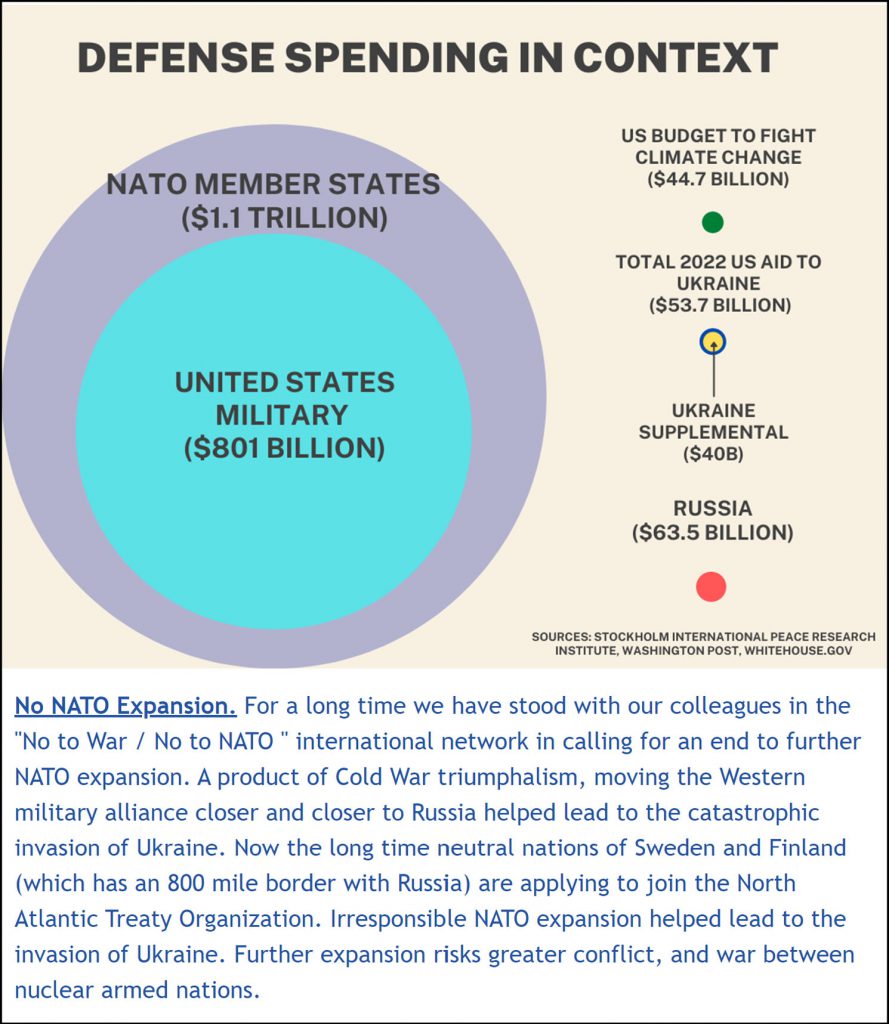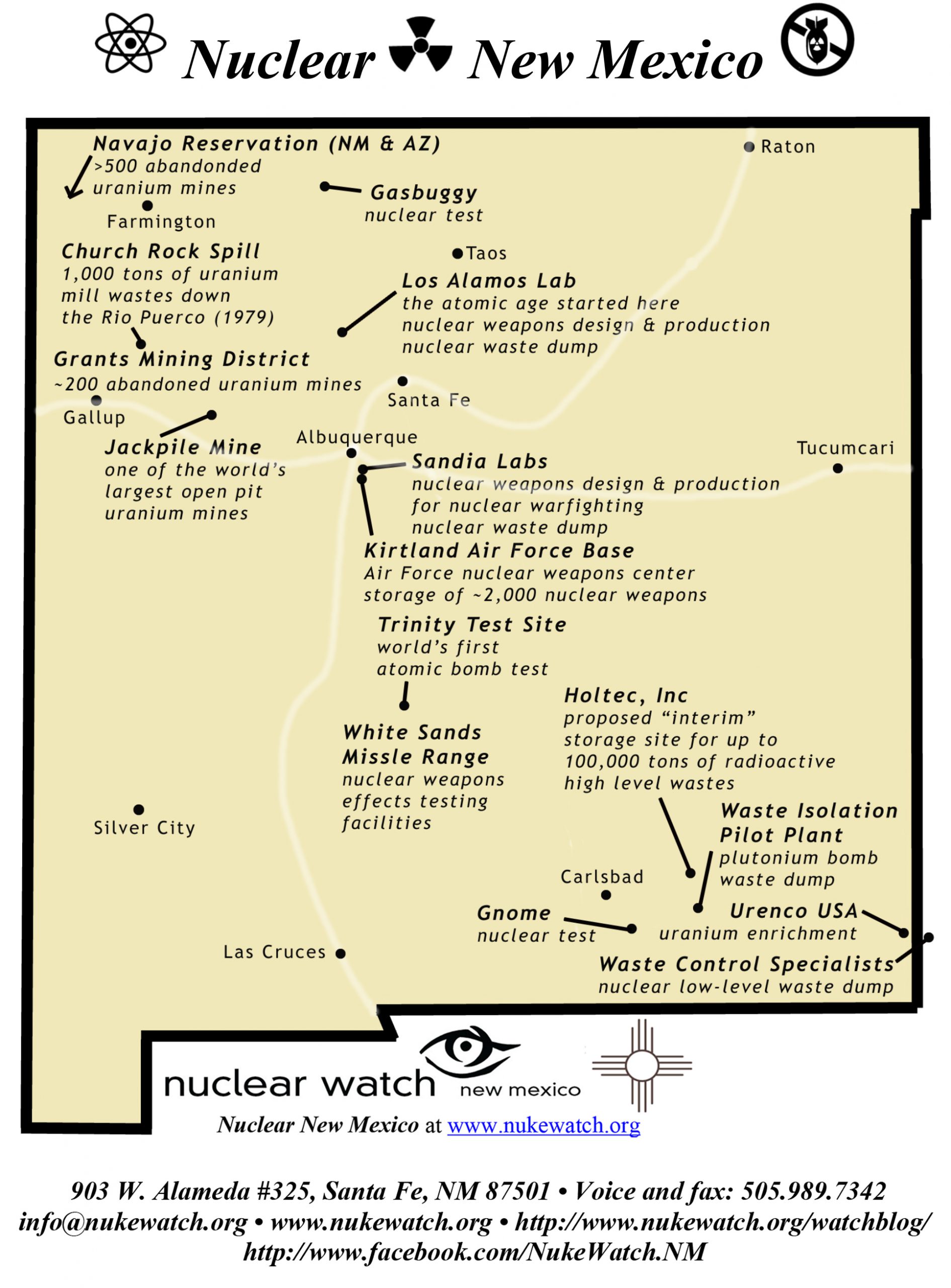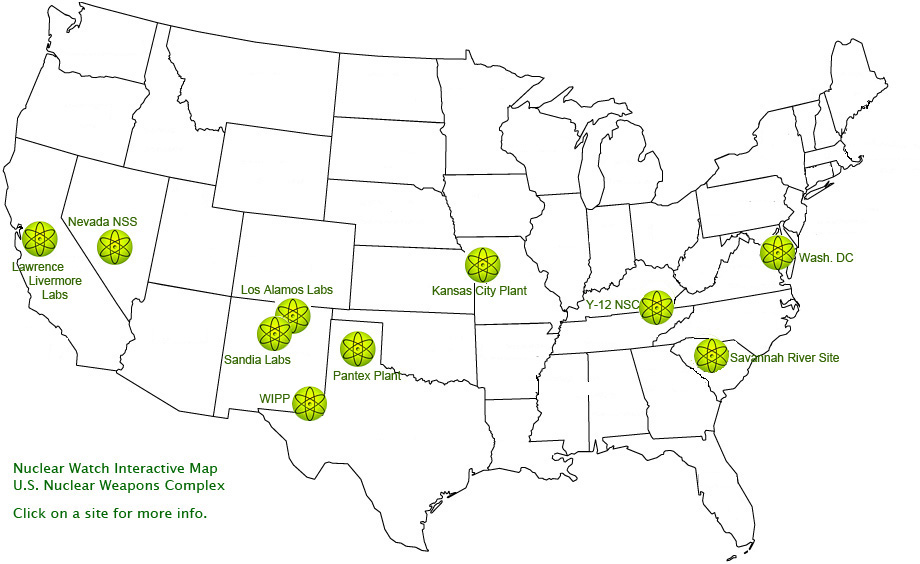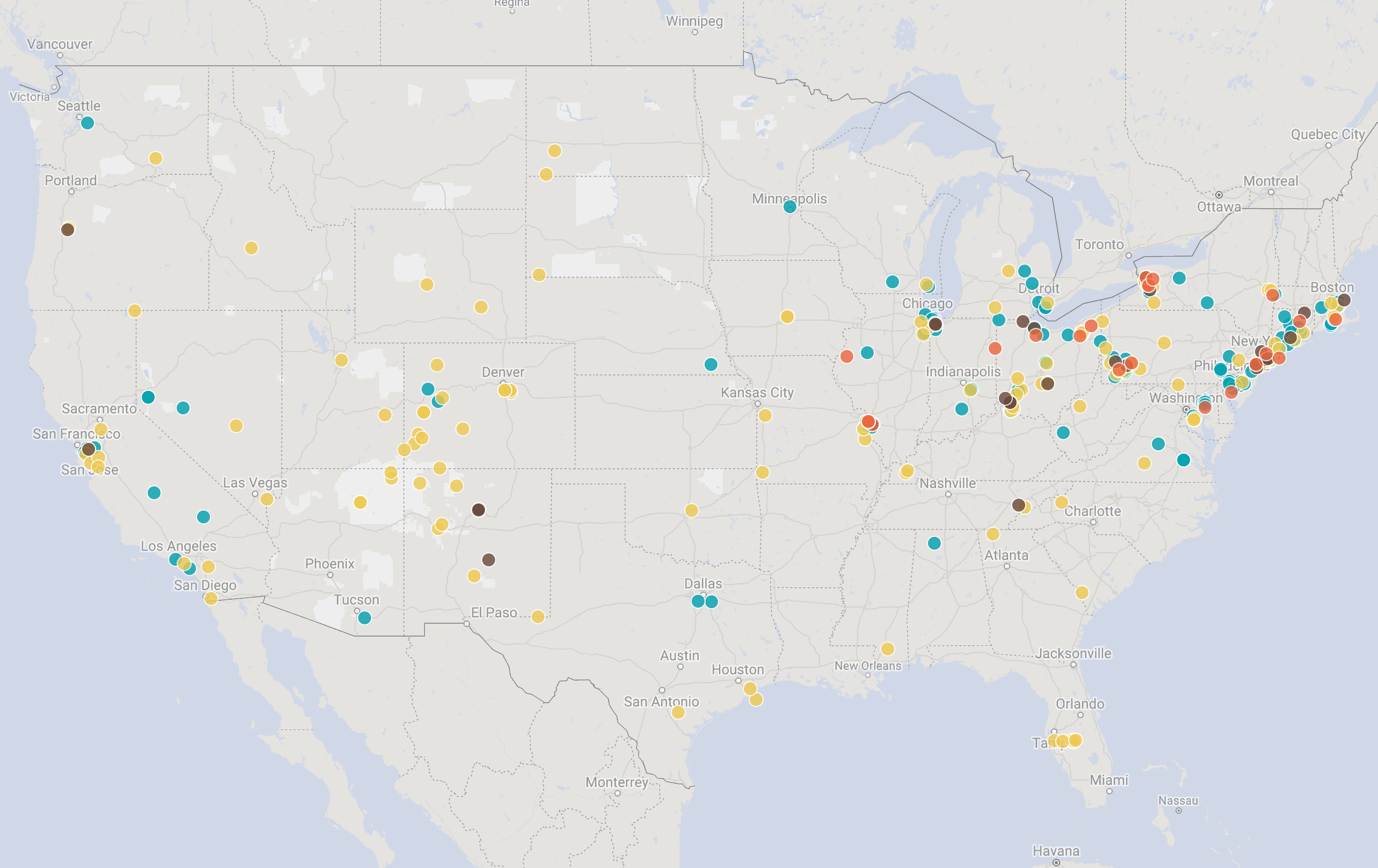QUOTE OF THE WEEK
Nothing Found
It seems we can’t find what you’re looking for. Perhaps searching can help.
LANL’s Central Mission: Los Alamos Lab officials have recently claimed that LANL has moved away from primarily nuclear weapons to “national security”, but what truly remains as the Labs central mission? Here’s the answer from one of its own documents:
LANL’s “Central Mission”- Presented at: RPI Nuclear Data 2011 Symposium for Criticality Safety and Reactor Applications (PDF) 4/27/11
Banner displaying “Nuclear Weapons Are Now Illegal” at the entrance in front of the Los Alamos National Lab to celebrate the Entry Into Force of the Nuclear Weapon Ban Treaty on January 22, 2021
Nothing Found
It seems we can’t find what you’re looking for. Perhaps searching can help.
Follow the Money!
Map of “Nuclear New Mexico”
Nuclear Watch Interactive Map – U.S. Nuclear Weapons Complex
In 1985, US President Ronald Reagan and and Russian President Mikhail Gorbachev declared that “a nuclear war cannot be won and must never be fought.”
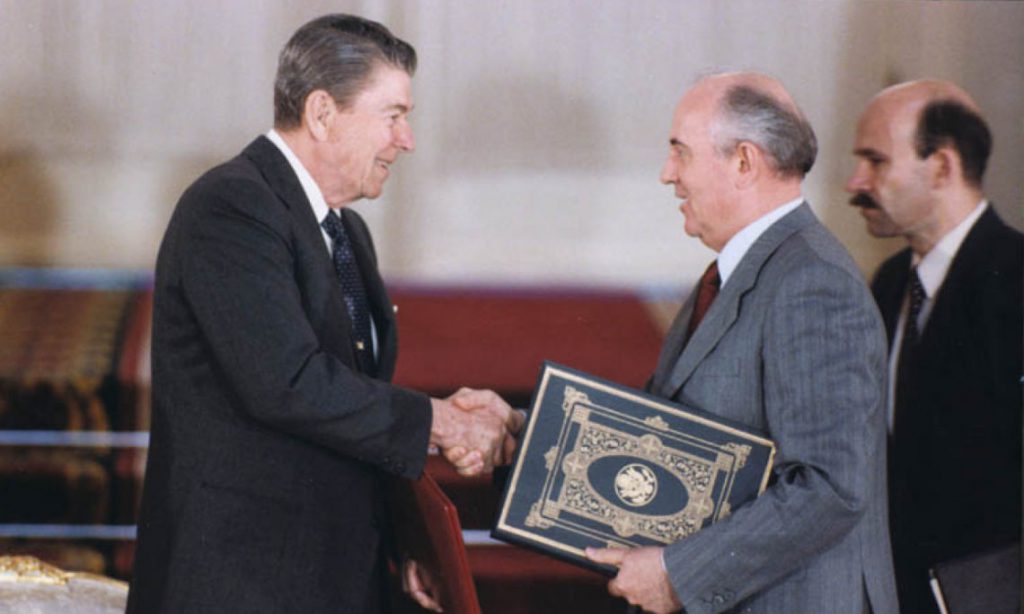
Waste Lands: America’s Forgotten Nuclear Legacy
The Wall St. Journal has compiled a searchable database of contaminated sites across the US. (view)
Related WSJ report: https://www.wsj.com
2022 BLOG POSTS
Nothing Found
It seems we can’t find what you’re looking for. Perhaps searching can help.
New & Updated
LANL Estimate of $2.9 Billion for “Remaining” Cleanup Leaves Nuclear & Toxic Wastes Behind and Kills Needed Jobs
For immediate release July 28, 2016
LANL Estimate of $2.9 Billion for “Remaining” Cleanup
Leaves Nuclear & Toxic Wastes Behind and Kills Needed Jobs
Santa Fe, NM – The Department of Energy (DOE) has announced that the cost of “Remaining Legacy Cleanup” of radioactive and toxic wastes from more than 70 years of nuclear weapons research and production at the Los Alamos National Laboratory (LANL) will cost $2.9 billion through fiscal year 2035, averaging $153 million per year.
That cost estimate clearly assumes that the Lab’s major radioactive and toxic wastes dumps will not be cleaned up. Instead they will be “capped and covered,” leaving some 200,000 cubic yards of radioactive and toxic wastes at Area G, its largest waste dump. Those wastes sit in unlined pits and trenches, 800 feet above groundwater and three miles uphill from the Rio Grande (plutonium contaminants have been detected 200 feet below Area G). During this same period of time the Lab’s nuclear weapons programs that caused the mess to begin with will cost ten times as much, even before expected funding increases for expanded production of plutonium bomb core “pits” and increasingly aggressive “Life Extension Programs” that give existing nuclear weapons new military capabilities.
DOE’s announcement also pegs the cost of past cleanup at LANL at $3.2 billion to date, raising the question of what has been and will be accomplished with precious taxpayer dollars. The answer is not much for the money. According to DOE’s own data, for the next couple of years only around a sixth of LANL’s “cleanup” funding will actually go to cleanup. Approximately one-third will be used to catch up on worker pensions and another third to babysit improperly treated radioactive waste barrels, one of which ruptured and closed the multi-billion dollar Waste Isolation Pilot Plant. More than half of the remaining one-third for real cleanup goes to LANL’s notoriously high overhead.
DOE’s cost estimate for future LANL cleanup assumes flat funding out to FY 2035, and notes how that cost is “Aligned to [the] 2016 Consent Order.” Despite repeated requests, DOE refused to estimate cleanup costs at LANL until a new Consent Order was finalized with the New Mexico Environment Department (NMED). Both agencies recently signed it, creating a giant loophole in which the Lab can claim that cleanup is too expensive or impractical to achieve. This is the exact opposite of the original 2005 Consent Order, whose underlying intent was to make DOE and LANL ask Congress for additional cleanup funding. Subsequently, funding for LANL cleanup has fallen from $224 million in FY 2014 to $189 million requested for FY 2017.
Under the Gov. Martinez Administration, NMED Secretary Ryan Flynn granted more than 150 milestone extensions to the 2005 Consent Order at the Lab’s request and then claimed that the old Consent Order did not work. Nuclear Watch New Mexico has filed suit against DOE and LANL for missing compliance milestones under the original Consent Order, with potential fines of more than $300 million. NMED explicitly absolves those violations and fines through the new Consent Order and has intervened in the lawsuit against NukeWatch. This raises the question of whose side the Environment Department is on, the environment or the polluter (in this case, a $2.3 billion per year nuclear weapons facility)?
DOE and NMED kill the chance for serious job creation at the Los Alamos Lab with a deceptive plan for so-called cleanup that leaves tons of radioactive and toxic wastes in the ground that will permanently threaten northern New Mexico’s precious water resources. In addition to the environmental and safety threats and contamination, nuclear weapons programs are not big producers of new jobs. For example, the environmental impact statement for a planned $6.5 billion plutonium facility for expanded nuclear weapons production explicitly stated that not one new Lab job would be created because it would merely relocate existing jobs. In contrast, a LANL study of full cleanup of Area G assumed that around 40% of the total cost would go to labor. Thus, as a rough approximation, for every additional billion dollars put into cleanup, another 3,000 years of cleanup work could be created for one hypothetical worker (in other words, hundreds of high paying jobs for the regional economy).
Jay Coghlan, NukeWatch Director, commented, “The Department of Energy and the New Mexico Environment Department deal New Mexicans a bad hand by pushing a plan that blocks genuine cleanup at the Los Alamos Lab. We need real cleanup that protects our precious water resources for future generations, not more nuclear bombs that cause the mess to begin with.”
# # #
DOE’s presentation on its cost estimate for future LANL cleanup is available at
LANL Estimate of $2.9 Billion for “Remaining” Cleanup Leaves Nuclear and Toxic Wastes Behind and Kills Needed Jobs
Santa Fe, NM.
The Department of Energy (DOE) has announced that the cost of “Remaining Legacy Cleanup” of radioactive and toxic wastes from more than 70 years of nuclear weapons research and production at the Los Alamos National Laboratory (LANL) will cost $2.9 billion through fiscal year 2035, averaging $153 million per year.
“That cost estimate clearly assumes that the Lab’s major radioactive and toxic wastes dumps will not be cleaned up. Instead they will be “capped and covered,” leaving some 200,000 cubic yards of radioactive and toxic wastes at Area G, its largest waste dump. Those wastes sit in unlined pits and trenches, 800 feet above groundwater and three miles uphill from the Rio Grande (plutonium contaminants have been detected 200 feet below Area G). During this same period of time the Lab’s nuclear weapons programs that caused the mess to begin with will cost ten times as much, even before expected funding increases for expanded production of plutonium bomb core “pits” and increasingly aggressive “Life Extension Programs” that give existing nuclear weapons new military capabilities…”
Nuclear Watch NM Amends LANL Cleanup Lawsuit – Claims New Consent Order To Be Invalid
 Nuclear Watch NM Amends LANL Cleanup Lawsuit – Claims New Consent Order To Be Invalid
Nuclear Watch NM Amends LANL Cleanup Lawsuit – Claims New Consent Order To Be Invalid
Nuclear Watch New Mexico has amended its federal lawsuit against the Department of Energy (DOE) and Los Alamos National Security, LLC (LANS) that alleges twelve violations of a 2005 Consent Order governing cleanup at the Los Alamos National Laboratory (LANL). Those violations could result in potential penalties of more than $300 million dollars that would go to the state, if only the New Mexico Environment Department (NMED) were to enforce them.
Nuclear Watch now asks the court to declare the new 2016 Consent Order to be invalid because the requirement for the opportunity of a public hearing was not met.
NMED intervened in the case on June 23, 2016. The next day, NMED and DOE signed the 2016 Consent Order after a 60-day comment period, during which over 40 citizens, nonprofit organizations, public officials, and two Pueblos provided comments. Lack of enforceability and lack of concrete long-term schedules were common major foci of the comments. Despite that, “No change” without any further explanation was NMED’s overwhelming response to specific public comments as the two agencies moved from the draft to final Consent Order.
The finalized new Consent Order surrenders enforceability by creating a giant loophole where DOE and LANL can avoid cleanup by claiming that it is either too expensive or impractical. This is clearly the opposite of what is needed, when nuclear weapons research and production programs that caused the mess to begin with are receiving increased taxpayer funding, while cleanup programs are being cut.
In addition, NMED’s new Consent Order explicitly absolves DOE and LANS of past violations. In response, Nuclear Watch has added to its lawsuit this request for declaratory judgment by the court that DOE and NMED violated the public’s right for the opportunity of a formal hearing, explicitly required by the 2005 Consent Order.
Scott Kovac, NukeWatch Research Director, noted, “We will not let the public’s right for cleanup at the Los Alamos Lab be papered over by DOE and NMED. Both agencies agreed to all parts of the 2005 Consent Order, which included rigorous public participation requirements and a detailed the cleanup schedule, including a final compliance date. We will continue to push for the public to have a true voice in these important matters. ”
The New Mexico Environmental Law Center and Attorney John E. Stroud are representing NukeWatch in this legal action to enforce timely cleanup at LANL.
###
Nuclear Watch New Mexico’s 1st amended complaint is available here
NMED’s Final Consent Order and the “response” to comments matrix are available here
Nuclear Watch New Mexico’s original lawsuit complaint is available here
Our May 5, 2016 second notice of intent to sue (which is a good summary of our complaint) is available here
Our January 20, 2016 notice of intent to sue is available here
Successful Citizen Activism Against Expanded U.S. Plutonium Pit Production
This is the unsung story of successful citizen activism against repeated government attempts to expand the production of plutonium pit cores, which has always been the choke point of resumed U.S. nuclear weapons production. This history is a critical part of the march toward a future world free of nuclear weapons.
Nuclear Watch NM Amends LANL Cleanup Lawsuit – Claims New Consent Order To Be Invalid
Santa Fe, NM
Nuclear Watch New Mexico has amended its federal lawsuit against the Department of Energy (DOE) and Los Alamos National Security, LLC (LANS) that alleges twelve violations of a 2005 Consent Order governing cleanup at the Los Alamos National Laboratory (LANL). Those violations could result in potential penalties of more than $300 million dollars that would go to the state, if only the New Mexico Environment Department (NMED) were to enforce them. Nuclear Watch now asks the court to declare the new 2016 Consent Order to be invalid because the requirement for the opportunity of a public hearing was not met.
NM Environment Dept Finalizes Consent Order on Los Alamos Lab Cleanup Surrenders Enforcement to Nuclear Weaponeers
NM Environment Dept Finalizes Consent Order
on Los Alamos Lab Cleanup
Surrenders Enforcement to Nuclear Weaponeers
Santa Fe, NM – In a classic move to avoid publicity, the New Mexico Environment Department (NMED) announced late Friday afternoon June 24 that it had finalized a new “Consent Order” to replace a 2005 Order governing cleanup at the Los Alamos National Laboratory (LANL). The Environment Department’s brief press release headlined “Agreement Focuses on Cleanup & Supporting Stronger Federal Funding Requests.” This is doublespeak, as the new Consent Order is a giveaway to the Department of Energy and the Lab, surrendering the strong enforceability of the old Consent Order. The new Order is also clearly the opposite of the old Consent Order, whose underlying intent was to make DOE and LANL get more money from Congress for accelerated cleanup. In contrast, the new Consent Order allows them to get out of future cleanup by simply claiming that it’s too expensive or impractical to clean up.
The nuclear weaponeers are now openly talking about the “The Second Nuclear Age” before cleaning up form the first nuclear age. They are actively seeking to expand nuclear weapons production that caused the widespread contamination to begin with, particularly plutonium pit production at LANL.
Jay Coghlan, Nuclear Watch New Mexico Director, commented, “The nuclear weaponeers plan to spend a trillion dollars over the next 30 years completely rebuilding U.S. nuclear forces. Meanwhile, cleanup at the Los Alamos Lab, the birthplace of nuclear weapons, continues to be delayed, delayed, delayed. Real cleanup would be a win-win for New Mexicans, permanently protecting our water and environment while creating hundreds of high paying jobs. But yet the Environment Department fails New Mexicans by failing to enforce cleanup at Los Alamos.”
When NMED Secretary Ryan Flynn announced a draft new Consent Order on March 30, he claimed that the old Consent Order did not work. Nuclear Watch agrees, but that’s because Secretary Flynn granted more than 150 compliance milestone extensions at the Lab’s request, effectively eviscerating the old Consent Order. While finalizing the new Consent Order NMED ignored the explicit public participation requirements of the old Order, which among other things requires a public hearing on major modifications. Instead, NMED rammed through the final Consent Order, largely brushing aside the formal comments of some 40 concerned citizens and the Santa Clara Pueblo.
LANL is key to the trillion dollar rebuilding of nuclear forces as the premier nuclear weapons design lab and the nation’s sole production site for plutonium pit triggers, the most critical nuclear weapons components. Funding for Department of Energy (DOE) nuclear weapons programs is nearly double historic Cold War averages, with around $1.5 billion spent annually at LANL alone. In contrast, funding for Lab cleanup has been cut to $189 million for FY 2017 (down from $225 million in FY 2014), with only approximately a third going to actual cleanup (one-third goes to pensions and another third to safeguard improperly treated radioactive waste barrels, one of which ruptured and closed the multi-billion dollar Waste Isolation Pilot Plant).
The original 2005 Consent Order required DOE and LANL to investigate, characterize, and clean up hazardous and mixed radioactive contaminants from 70 years of nuclear weapons research and production. It also stipulated a detailed compliance schedule that the Lab was required to meet. Ironically, the last milestone, due December 6, 2015, required a report from LANL on how it successfully cleaned up Area G, its largest waste dump. However, real cleanup remains decades away, if ever. Instead, the Lab plans to “cap and cover” Area G, thereby creating a permanent nuclear waste dump in unlined pits and shafts, with an estimated 200,000 cubic yards of toxic and radioactive wastes buried above the regional groundwater aquifer, four miles uphill from the Rio Grande.
A few of the serious deficiencies of the new Consent Order are:
[Quotes are from the new Consent Order followed by page numbers]
• “The Parties agree that DOE’s project’s plans and tools will be used to identify proposed milestones and targets.” P. 28. “DOE shall define the use of screening levels and cleanup levels at a site…” P. 32. This puts the Department of Energy in the driver’s seat, not the New Mexico Environment Department.
• “DOE shall update the milestones and targets in Appendix B on an annual basis, accounting for such factors as… changes in anticipated funding levels.” P. 29. Therefore the new Consent Order will be held hostage to DOE’s budget, which recently cut LANL’s cleanup funding.
• “… [DOE and NMED] shall meet to discuss the appropriation and any necessary revision to the forecast, e.g. DOE did not receive adequate appropriations from Congress…” P. 30. Again, the new Consent Order and therefore cleanup at LANL will be held hostage to DOE funding, when DOE’s own track record makes clear that its priority is expanded nuclear weapons production paid for in part by cutting cleanup and nonproliferation programs.
• “If attainment of established cleanup objectives is demonstrated to be technically infeasible, DOE may perform risk-based alternative cleanup objectives…” P. 34. DOE can opt out because of “impracticability” or cost of cleanup. P. 35. This creates giant loopholes that threaten comprehensive cleanup at LANL.
• The new draft Consent Order explicitly states that public participation requirements do NOT apply to future modifications of the Order. P. 25. This is the opposite of what the original Consent Order required, which made a point of incorporating the public process requirements of federal environmental law. Nuclear Watch New Mexico maintains that full public participation requirements apply to the new Consent Order as well, including its very formulation as a major modification of the old Consent Order. That full public participation process requires a public hearing if there are unresolved issues, which NMED has rejected, a position that may be of questionable legality.
On May 12, 2016, Nuclear Watch New Mexico filed a lawsuit against LANL and DOE for failing to meet compliance milestones in the old Consent Order. These violations incur around $300 million dollars in potential penalties, which NMED shows no sign of enforcing. To the contrary, NMED has filed a motion to intervene against Nuclear Watch New Mexico in its lawsuit, raising the question of whose side the Environment Department is on, the environment or the polluter (in this case a for-profit nuclear weapons lab)?
Moreover, when Nuclear Watch NM filed a notice of intent to sue on January 21, NMED Secretary Flynn sought to intimidate our lawyers by declaring “If a suit is filed, and the Environment Department becomes involved, we would insist on collecting any and all labor and legal costs from the (New Mexico Environmental Law Center) to reimburse New Mexico’s taxpayers for the costs resulting from this groundless and frivolous action.”
Far from being a frivolous action, Nuclear Watch and the New Mexico Environmental Law Center seek to compel full and genuine environmental restoration at the Los Alamos Lab, which the new Consent Order blocks by giving the nuclear weaponeers giant loopholes to avoid cleanup.
# # #
NMED’s June 24 press release and the new Consent Order are available here
Nuclear Watch New Mexico’s lawsuit complaint, filed May 12, 2016, is available here
- Our complaint alleged twelve counts of milestone compliance violations where NMED did not grant extensions. At that time we calculated 7,853 total days of noncompliance at $37,500.00 per day, equal to $294,487,500, with the clock still ticking.
Our January 20, 2016 notice of intent to sue is available here

NM Environment Dept. Finalizes Consent Order on Los Alamos Lab Cleanup; Surrenders Enforcement to Nuclear Weaponeers
Santa Fe, NM
The new Consent Order is a giveaway to the Department of Energy and the Lab, surrendering the strong enforceability of the old Consent Order. The new Order is also clearly the opposite of the old Consent Order, whose underlying intent was to make DOE and LANL get more money from Congress for accelerated cleanup. In contrast, the new Consent Order allows them to get out of future cleanup by simply claiming that it’s too expensive or impractical to clean up…
University of New Mexico’s growing involvement in nuclear weapons prograns
See Honeywell, UNM sign accord to pursue joint research
This is more evidence of the University of New Mexico’s deepening involvement in nuclear weapons programs. UNM recently announced that with Boeing, the U. of Texas and others that it was going to bid on the Sandia Labs management contract.
Honeywell runs the new Kansas City Plant, which is manufacturing and/or procuring ~100,000 nonnuclear nuclear weapons components every year for increasingly aggressive Life Extension Programs. These programs not only extend the service lives of nuclear weapons for up to 60 years, but also give them new military capabilities, despite denials at the highest levels of the U.S. government.
UNM is also the host site for the June 21 Strategic Deterrence Symposium featuring top military and Energy Dept. nuclear brass. Nuclear Watch NM will be there to see what they are to.
Obama’s Speech in Hiroshima
Obama’s speech is beautiful and very moving.
But he’ll be gone soon while the one trillion dollar modernization of U.S. nuclear forces that begins under him will go on for 30 years and then some (unless we stop it, that is).
Text of President Obama’s Speech in Hiroshima, Japan
MAY 27, 2016
Sign the Petition – No Loopholes, No Excuses – Full Cleanup at Los Alamos!
Dear Friends,
Thanks to those who made it to the meeting last night!
NukeWatch has a new petition –
The New Mexico Environment Department (NMED) has issued a proposed new “Consent Order” governing cleanup at the Los Alamos National Laboratory, the birthplace of nuclear weapons.
We demand NMED close the giant loophole in the proposed Consent Order that would allow Los Alamos Lab and DOE to get out of cleanup by simply saying that they don’t have enough money.
And we demand NMED hold a public hearing on the proposed Consent Order, given the intense public interest in cleaning up the Lab.
https://www.change.org/p/kathryn-roberts-no-excuses-no-loopholes-full-cleanup-at-los-alamos-lab
AND WE HAVE EXPANDED OUR SAMPLE COMMENTS FOR YOU TO USE AS YOU SEE FIT
Please let your voice be heard and turn in public comments.
Copy the sample comments below and paste into an email.
Please modify as you see fit, then email to the address below.
If you don’t mind, please cc: us at: info(at)nukewatch(dot)org
[date]
Ms. Kathryn Roberts
New Mexico Environment Department
Post Office Box 5469
Santa Fe, New Mexico 87502
Via email to kathryn.roberts@state.nm.us
Dear Ms. Roberts,
I urge the New Mexico Environment Department (NMED) to abandon the proposed 2016 Compliance Order on Consent, or Consent Order, for Los Alamos National Laboratory (LANL), released for public comment on March 30, 2016. It creates serious problems and represents a giant step backwards in achieving the goal of genuine cleanup of the Laboratory.
The Environment Department should keep the existing Consent Order that went into effect March 1, 2005, while modifying and updating a cleanup schedule that includes a realistic final compliance date. I also formally request that NMED provide the opportunity for a public hearing on the revised cleanup schedule and new completion date, in accordance with the New Mexico Hazardous Waste Act and the 2005 Consent Order.
GENERAL COMMENTS
The opportunity for a public hearing must be provided
- Any extension of a final compliance date must be treated as a Class 3 permit modification to the 2005 Consent Order and therefore requires a 60-day public comment period.
- Any extension of a final compliance date under the 2005 Consent Order can be implemented only after the opportunity for public comment and a public hearing, including formal testimony and cross-examination of witnesses.
- The Environment Department is legally required to follow these public participation requirements that explicitly incorporated into the 2005 Consent Order.
Withdraw the proposed draft 2016 Consent Order
- The proposed draft represents a big step backwards in achieving the goal of genuine cleanup of the Laboratory.
- The Environment Department should keep the current 2005 Consent Order and revise the Section XII cleanup schedule and final compliance date.
- I request that the Environment Department withdraw the proposed draft 2016 Consent Order.
The public deserves the opportunity to comment on all following drafts
- It seems likely that a later draft – after the Lab’s and public comments are incorporated into a revised draft – and after closed-door negotiations between the Environment Department and the Laboratory – could be substantially different from the current draft.
- I request that the public have the opportunity to review and comment on any further drafts of a revised proposed 2016 Consent Order.
Public participation provisions in the existing 2005 Consent Order must be incorporated into the proposed draft 2016 Consent Order
- The proposed draft 2016 Consent Order explicitly limits public participation requirements incorporated into the existing 2005 Consent Order.
- I request that all notices, milestones, targets, annual negotiations, and modifications require public review and comment, and the opportunity for a public hearing.
The current state of cleanup must be updated and next steps scheduled
- Work under the existing 2005 Consent Order needs to be subject to public review. In 2005 DOE agreed to complete cleanup under the Consent Order by December 6, 2015, which did not happen. In order for the public to understand where the work under the existing Consent Order stands, LANL should be required to provide a current, publicly available list of the status of all cleanup projects under the 2005 Consent Order.
- Further, I request that next steps for cleanup at every site listed in the 2005 Consent Order be documented in detail and given a scheduled completion date, or alternatively verified as already completed.
- All documents submitted under the 2005 Consent Order must be incorporated into any revised Consent Order.
All documents must be made public as required in the 2005 Consent Order
- The State and the Lab must make all communications, documents, submittals, approvals, notices of deficiencies and denials under any revised Consent Order readily and electronically available to the public.
- The State and the Lab must notify individuals by e-mail of all submittals, as required in the 2005 Consent Order.
The Environment Department must respond in writing to all public comments
- I request that the State reply individually to each and every comment submitted.
- The Lab’s comments and NMED’s response to comments must be made public.
All future work must have enforceable deadlines
- The proposed draft 2016 Consent Order proposes a “Campaign” approach with enforceable cleanup deadlines limited to the work scheduled only for that year.
- I request that all anticipated cleanup projects have scheduled, enforceable cleanup deadlines from the beginning of any revised Consent Order.
The Consent Order cannot be open-ended
- Any Consent Order for LANL cleanup must have a final compliance date to which the State and the Lab agree to and are so bound.
- The public should be given an opportunity for a public hearing on the new final compliance date as required by New Mexico’s hazardous waste regulations.
SPECIFIC COMMENTS
The Proposed 2016 Consent Order Must Not Extend the Original Final Compliance Date Without Required Public Participation
The proposed 2016 consent order would indefinitely extend the final compliance date for completing corrective action at the Laboratory, without the opportunity for a public hearing with formal testimony and cross-examination of witnesses. Any extension of a final compliance date under the 2005 Consent Order requires a 60-day public comment period and the opportunity for a public hearing, including formal testimony and cross-examination. The Environment Department is legally required to follow these procedural requirements.
The legal requirements that mandate a public hearing are clear. Section XII of the 2005 Consent Order establishes the compliance schedule for implementation and completion of corrective actions at specific sites at the Laboratory. This schedule is mandatory. The final report that was to be submitted under the 2005 Consent Order – therefore, the final compliance date – was the remedy completion report for the huge Area G waste dump, required to be submitted by December 6, 2015. The proposed 2016 Consent Order would indefinitely extend this final compliance date by not designating a specific final compliance date.
But this revision must be treated as a major Class 3 permit modification. Section III.W.5 of the 2005 Consent Order explicitly provides for the preservation of full procedural rights for the public as follows:
This Consent Order hereby incorporates all rights, procedures and other protections afforded the Respondents [DOE and UC, now LANS] and the public pursuant to the regulations at 20.4.1.900 NMAC (incorporating 40 C.F.R. § 270.42) and 20.4.1.901 NMAC, including, but not limited to, opportunities for public participation, including public notice and comment, administrative hearings, and judicial appeals concerning, for example, remedy selection decisions of the [Environment] Department.
Thus, extension of a final compliance date under the 2005 Consent Order requires a 60-day public comment period and the opportunity for a public hearing, including formal testimony and cross-examination.
The Proposed New Consent Order Must Not Limit Other Public Participation Procedures
The proposed 2016 Consent Order expressly limits public participation requirements in a way that completely diverges from those provided in the 2005 Consent Order. As explained above, the 2005 Consent Order explicitly protects procedural due process rights available to the public. The proposed 2016 Consent Order explicitly removes these protections, as follows:
The Parties agree that the rights, procedures and other protections set forth at 20.4.1.900 NMAC (incorporating 40 C.F.R. § 270.42), 20.4.1.901 NMAC, and 20.4.1.902 NMAC, including, but not limited to, opportunities for public participation, including public notice and comment, administrative hearings, and judicial appeals, do not apply to modification of the Consent Order itself. [Emphasis added]
Thus, as proposed in the above language, the Parties (the Environment Department, Department of Energy and Los Alamos National Security, LLC) have inappropriately agreed to remove the due process rights, procedures and other protections provided to the public under the Resource Conservation and Recovery Act (RCRA) and the New Mexico Hazardous Waste Act. This provision must be stripped from the proposed 2016 Consent Order.
The Proposed New Consent Order Must Not Eliminate Enforceable Deadlines
The proposed 2016 consent order would eliminate all the deadlines for completing cleanup under the 2005 Consent Order, and replace them with an open-ended and vague scheduling process, with limited enforcement opportunities.
The 2005 Consent Order, in Section XII, established dozens of deadlines for the completion of corrective action tasks, including completion of investigations at individual sites, installation of groundwater monitoring wells, submittal of groundwater monitoring reports, evaluation of remedial alternatives for individual sites, and completion of final remedies. These deadlines are enforceable under section III.G.
The proposed 2016 Consent Order would abandon the 2005 Consent Order provisions and replace them with a so-called “Campaign Approach” under Section VIII. Under Section VIII.A.3, it would be up to the DOE, not the regulator at the New Mexico Environment Department, to select the timing and scope of each “campaign.”
Enforceable deadlines for cleanup tasks would apply no more than one year into the future. Deadlines would be based on “Campaigns” negotiated each year with DOE with no public participation and opportunity to comment on the schedule. To add insult to injury, the annual schedule would be determined by funding at DOE’s discretion, rather than the schedule driving the funding, which was the fundamental approach of the 2005 Consent Order.
All cleanup projects must mandatory completion dates scheduled from the beginning date of any revised Consent Order, and must be fully enforceable.
Existing Violations Must Not Be Eliminated
Section II.A of the proposed 2016 Consent Order would “settle any outstanding violations of the 2005 Consent Order.” This is a get out of jail free card. Without enforceable schedules from the beginning, any consent order is not truly unenforceable, and the Environment Department would be abdicating its responsibility to protect human health and the environment as required by the federal Resource Conservation and Recovery Act (RCRA) and the New Mexico Hazardous Waste Act. NMED must not surrender its regulatory and enforcement powers!
Attorney General Approval Must Be Obtained
The 2005 Consent Order was signed by the Attorney General of New Mexico for purposes of the Covenant Not to Sue (section III.) and the Reservation of Rights (section III.). As indicated on the draft signature page, there is no indication of the NM Attorney General plans to sign the proposed 2016 Consent Order. Yet it would provide the State of New Mexico with a covenant not to sue DOE on behalf of the State of New Mexico, not merely on behalf of the Environment Department. The Attorney General was an active participant, representing the People of New Mexico, in the 2005 Consent Order. The Environment Department has a responsibility to ensure that the NM Attorney General is consulted, and his approval obtained, before any consent order is adopted.
The Proposed 2016 Consent Order Must Not Omit Detailed Requirements Found in the 2005 Consent Order
The 2005 Consent Order includes numerous detailed requirements for such things as well installation, sample collection, and preparation of work plans and reports. These ensure that the cleanup work is done properly, consistently, and according to standard industry practices. They also ensured that work plans and reports were consistent, easy for the Environment Department to review, and easy for the public to understand. The proposed 2016 Consent Order omits many such requirements, which should be corrected.
The Proposed 2016 Consent Order Must Not Allow Budget To Dictate Cleanup
The proposed 2016 Consent Order allows DOE to provide cleanup priorities based on anticipated budget, which is backwards. . By the time NMED receives an estimated annual cleanup budget from DOE, the horse has left the barn. The original purpose of the 2005 Consent Order was to compel DOE and LANL to ask Congress for additional funds to accelerate cleanup. The giant loophole in the proposed 2016 Consent Order that allows DOE and LANL to say that they don’t have sufficient funding and therefore can choose to exempt themselves from cleanup should be eliminated.
Cleanup Levels Must Remain Strict
Section IX Cleanup Objectives and Cleanup Levels of the proposed 2016 Consent Order would allow DOE to “develop site specific ecological cleanup levels” to mitigate unacceptable ecological risk due to release of site-related contaminants. There is no mention of NMED’s role in this process. DOE would be allowed to demonstrate to NMED that any particular “cleanup objective is impracticable.” To do this, DOE may consider such things as technical difficulty, the cost of the project, hazards to workers or to the public, and any other basis that may support a finding of impracticability. If NMED approves the impracticability request, DOE can then propose alternative cleanup methods using site-specific risk assessments. All of this could take place behind closed doors, as there are no public participation requirements in this section. Please clarify what cleanup levels will be used and when and where they will be applied.
New Mexico deserves better
In closing, the Environment Department’s proposed 2016 Consent Order allows the federal government to leave Northern New Mexico contaminated if DOE believes that cleanup is too difficult or costly– a sorry situation indeed for a nuclear weapons facility that receives over 2 billion taxpayer dollars a year. Instead, the New Mexico Environment Department should implement a new revised Consent Order that is aggressive and enforceable and in which the State of New Mexico stays in the driver’s seat, not LANL and DOE. That would be a real win-win for New Mexicans, helping to permanently protect the environment and our precious water resources while creating hundreds of high-paying cleanup jobs. .
Sincerely,
Name
City
The new draft Consent Order is available at
https://www.env.nm.gov/HWB/lanlperm.html#COOC
NMED’s public notice for the draft Consent Order is available at
https://www.env.nm.gov/HWB/documents/PublicNotice__English.pdf
The public comment period ends 5:00 pm May 31, 2016.
Comments should be submitted to kathryn.roberts@state.nm.us
Public Meeting: Los Alamos Cleanup at the Crossroads
Dear Friends,
Please join us for an informal public meeting Tuesday, May 24 at 6pm.
Main Library Community Room, 145 Washington Ave, Santa Fe, NM
Please remember that no refreshments are allowed at the Library.
See you there!
Los Alamos Cleanup at the Crossroads
A Discussion on the Future of Cleanup at Los Alamos
We have opportunities to take new directions
How do we get to the Northern New Mexico we want leave for future generations?
Learn how your input can help make better cleanup decisions at Los Alamos National Laboratory
Join us for a
Public Meeting: Tuesday May 24, 2016, 6 – 7:30pm
at the
Main Library Community Room, 145 Washington Ave, Santa Fe
Topics to be Addressed
Los Alamos Cleanup Order
- For “fence-to-fence” cleanup of legacy Cold War wastes
- The 10-year trip since the original Consent Order was signed in 2005
- New “Consent Order” Proposed by the NM Environment Department
- Proposed changes from the existing
- What can be improved?
- Who is in the driver’s seat?
- Just along for the ride, or will the public have real input?
- Public comments due May 31
Department of Energy’s new Environmental Management at Los Alamos
- Cleanup work no longer under nuclear weapons work
- Looking for a new contractor
- Can cleanup accelerate?
Nuclear Watch’s lawsuit
- Alleging violations of the 2005 Consent Order
Questions, answers, and discussion
- What’s on your mind
- Your comments are important
Brought to you by Nuclear Watch New Mexico
(505) 989-7342
info@nukewatch.org
www.nukewatch.org

Public Meeting, Los Alamos Cleanup at the Crossroads, 6:00 pm Tuesday May 24
Los Alamos Cleanup at the Crossroads
Public Meeting
6 – 7:30pm, Tuesday May 24, 2016
Community Room, Main Library, 145 Washington Ave, Santa Fe
Presentation on the Future of Cleanup at Los Alamos:
What the public needs to know and how to get involved and be informed
• Focus on new cleanup order proposed by the NM Environment Dept. and its lack of enforceability.
• Public comments due May 31
• New Energy Dept. Environmental Management at the Lab – same as the old boss?
• Nuclear Watch’s lawsuit
• Questions and answers
Brought to you by Nuclear Watch New Mexico
(505) 989-7342 info@nukewatch.org
www.nukewatch.org <https://nukewatch.org>
Nuclear Watch NM Files Lawsuit Over Lack of Cleanup at the Los Alamos Lab
May 17, 2016
Nuclear Watch NM Files Lawsuit
Over Lack of Cleanup at the Los Alamos Lab;
NM Environment Dept. Forgoes Nearly $300 Million in Penalties
Santa Fe, NM – Nuclear Watch New Mexico has filed a lawsuit in federal court against the Department of Energy and Los Alamos National Security LLC (LANS), the for-profit operator of the Los Alamos National Laboratory, over their failure to meet cleanup milestones under a 2005 “Consent Order” they agreed to with the New Mexico Environment Department. The New Mexico Environmental Law Center is representing NukeWatch in this legal action to enforce cleanup at LANL.
The suit was filed under the citizen suit provisions of the federal Resource Conservation and Recovery Act (RCRA), which the 2005 Consent Order explicitly incorporated. The law provides that any person who violates any requirement of RCRA is liable for a civil penalty up to $37,500 for each day of violation. Our suit claims twelve violations, which range in length of time of up to 675 days each. Our current cost estimate of the alleged violations approaches 300 million dollars and counting.
Jay Coghlan, NukeWatch Executive Director, commented, “The federal government plans to spend a trillion dollars over the next 30 years completely rebuilding U.S. nuclear forces. Meanwhile, cleanup at the Los Alamos Lab, the birthplace of nuclear weapons, continues to be delayed, delayed, delayed. We seek to make the for-profit nuclear weaponeers cleanup their radioactive and toxic mess first before making another one for a nuclear weapons stockpile that is already bloated far beyond what we need. Real cleanup would be a win-win for New Mexicans, permanently protecting our water and environment while creating hundreds of high paying jobs.”
In 2005 the New Mexico Environment Department compelled DOE and the University of California (LANL’s manager at the time) to enter into a detailed Consent Order that mapped the way toward comprehensive cleanup at LANL. However, beginning in 2011 with Governor Martinez’s administration, the New Mexico Environment Department allowed LANL’s new contractor, the for-profit Los Alamos National Security, LLC, to stop virtually all cleanup, instead engaging in a “campaign” to move above ground, monitored radioactive transuranic wastes to the Waste Isolation Pilot Plant (WIPP). That campaign ended in disaster when an improperly treated radioactive waste drum from LANL ruptured, contaminating 21 workers and indefinitely closing that multi-billion dollar facility.
The 2005 Consent Order required DOE and LANL to investigate, characterize, and clean up hazardous and mixed radioactive contaminants from 70 years of nuclear weapons research and production. It also stipulated a detailed compliance schedule that the Lab was required to meet. Ironically, the last milestone, due December 6, 2015, required a report from LANL on how it successfully cleaned up Area G, its largest waste dump. However, real cleanup remains decades away, if ever. The Lab plans to “cap and cover” Area G, thereby creating a permanent nuclear waste dump in unlined pits and shafts, with an estimated 200,000 cubic yards of toxic and radioactive wastes buried above the regional groundwater aquifer, four miles uphill from the Rio Grande.
Scott Kovac, NukeWatch Research Director, noted, “DOE and NMED agreed to all parts of the 2005 Consent Order, including the schedule. Then under the Martinez administration NMED granted more than 150 extensions requests, and DOE and LANS have still missed many of those deadlines. NukeWatch has taken this necessary step to enforce cleanup at LANL, to hold DOE accountable for protecting New Mexicans and make cleanup of legacy wastes the top priority. It’s ridiculous that we have to have this cleanup debate after 70 years of contamination from nuclear weapons research and production.”
The New Mexico Environment Department has issued a draft revised proposed Consent Order, for which the public comment period expires on May 31. The proposed new Consent Order specifically states that it “supersedes the 2005 Compliance Order on Consent (2005 Consent Order) and settles any outstanding alleged violations under the 2005 Consent Order.” (Sec. II.A.) This then would absolve DOE and LANS of nearly $300 million in potential penalties.
Moreover, the new draft Order puts DOE in the driver’s seat instead of New Mexico. It explicitly states that, “DOE’s project plans and tools will be used to identify proposed milestones and targets” (p. 27) and “DOE shall define the use of screening levels and cleanup levels” (p. 31) Moreover, DOE can opt out of any cleanup because of “impracticability” or cost of cleanup (p. 34) and that “DOE shall update the milestones…. [according to] changes in anticipated funding levels.” (p. 28). So the new Consent Order is made subordinate to DOE’s budget, which has been cutting cleanup while increasing funding for nuclear weapons programs that caused the mess to begin with. This is the opposite of the original Consent Order, whose intent was to make DOE and LANL get increased funding for cleanup.
The relief or remedy that Nuclear Watch New Mexico seeks through its lawsuit is simple, asking the Court to enter a judgment “Enjoining the Defendants [DOE and LANS] to take action to come into compliance with the March 1, 2005 Consent Order, as amended on October 29, 2012, according to a reasonable but aggressive schedule ordered by this Court…”
With that, Nuclear Watch New Mexico hopes to get real, comprehensive cleanup back on track at the Los Alamos National Laboratory.
# # #
Nuclear Watch New Mexico’s lawsuit complaint is available at https://nukewatch.org/importantdocs/resources/NukeWatch-Complaint-Filed-20160512.pdf
Our complaint alleges twelve counts of milestone compliance violations where NMED did not grant extensions. From there we calculate 7,853 total days of noncompliance at $37,500.00 per day, equal to $294,487,500, with the clock still ticking.
Our May 5, 2016 second notice of intent to sue (which is a good summary of our complaint) is available at https://nukewatch.org/importantdocs/resources/NukeWatch-2nd-NOI-DOE-LANS-5-5-16.pdf
Our January 20, 2016 notice of intent to sue is available at https://nukewatch.org/importantdocs/resources/NukeWatch-NM-NOI-to-DOE-and-LANS-20160120.pdf
NMED’s revised Consent Order is available at http://energy.gov/em/nnmcab/downloads/nmed-revised-lanl-consent-order-draft-march-2016
Consolidated Nuclear Security LLC Performance Evaluation Report – Wrong B61-12 tail case?
Buried in the just released NNSA FY 2015 Performance Evaluation Report (PER) for Consolidated Nuclear Security LLC (the combined contract for Pantex and Y-12 run by Lockheed Martin and Bechtel) is the remarkable note that Pantex sent to the Defense Department a Joint Test Assembly (JTA) of the B61-12 nuclear smart bomb with the wrong tail case. Generally, a JTA is a full scale mock up of the nuclear weapon (just not nuclear armed), in this case for a real life drop test from an Air Force fighter at the Tonapah Test Range in Nevada (which is run by the Sandia Labs).
P. 5: “CNS experienced several issues with the builds of the new B61 JTA Modernization configurations. CNS experienced quality issues on five of the six First Production Units. The most severe of which was the installation of an incorrect tail case on the JTA S/N 602 that was delivered to Department of Defense (DoD). The DoD chose not to proceed with the flight test and returned the unit to Pantex.” [S/N is the serial number of the particular unit.] – End –
How do you put the wrong tail case on the mock bomb, especially given all the hoopla we’ve heard about the B61-12 and the rush to get it into production? Did this involve the now-well known tail fin kit that turns the “dumb” B61 bomb into the precision-guided B61-12?
A few other worthy items from the CNS PER:
• p. 5: Pantex is falling behind in dismantlements, and this is before the announced planned 20% increase in dismantlements. “CNS achieved 101% of dismantlements related to secondaries and 66% of the revised Production Control Document (PCD) baseline schedule. The low performance against the revised PCD baseline schedule resulted in NNSA falling below the trajectory to achieve the 2022 dismantlement goal.”
Secondaries are dismantled at Y-12, with all of the rest of the nuclear weapon dismantled at Pantex. The 2022 dismantlement goal is to dismantle the ~2,500 nuclear weapons scheduled by 2009 for dismantlement. This does not include any weapons retired since then.
• p. 7: “CNS did not meet the majority of the expectations for scheduled surveillance activities, deliverables, and requirements as documented within each applicable weapons system approved Integrated Weapon Evaluation Team (IWET) Plans and associated directive documents.”
Rigorous surveillance is the prerequisite for maintaining stockpile safety and reliability (the claimed rationale for the Stockpile Stewardship Program), but has chronically suffered lower prioritization.
• p. 10: “W76-1 LEP: CNS achieved 101% of the secondary production schedule, met the military shipment schedule, but only achieved 85% of the total FY15 delivery commitment to the Department of Defense.”
This doesn’t bode well for future Life Extension Programs that are growing only more complex and ambitious.
• p. 11: “CNS is behind schedule on pit recertification projects and is working on recovery plans. The CNS delays have not adversely impacted the B61-12 schedule. However, if delays continue the impacts to the B61-12 schedule are certain.”
• p. 14: The future uranium casting process for the Uranium Processing Facility is still unproven.
“CNS did not fully meet expectations on the use of the production microwave caster in [Building] 9212 [at Y12]. This is partially due to equipment issues including the stack 11 filter issues and a failure in the microwave’s bottom lift assembly. Unfortunately, CNS was unable to recover the schedule. Running the microwave caster early and often is valuable since this technology represents the future Uranium Processing Facility (UPF) casting capability.”
• p. 24: Pantex and Y-12 are beginning “additive manufacturing” (3-D printing) of nuclear weapons components. What are the future proliferation consequences of this?
“CNS began advancing manufacturing capabilities through additive manufacturing initiatives. CNS procured and received a Connex 500-UV Resin multi-color, large-scale plastic machine. This machine will be used for prototyping, proof of principle, displays and cutaways, and training aids. CNS also procured its first metal additive machine and installation will begin at Y-12 in July. Once R&D material testing is complete, the first area of focus will be tooling applications. A second, identical machine has been procured for Pantex and will be delivered late summer for similar applications.”
• p. 35: CNS, composed of Lockheed Martin and Bechtel, gave the construction contract for the Uranium Processing Facility at Y-12 to Bechtel. There was no competition that I heard about.
Concerning Bechtel’s track record, it took the Chemistry and Metallurgy Research Replacement Project at LANL from an original $600 million to $6 billion, and the Waste Treatment Facility at Hanford from $3.5 billion to $13 billion, and it may still never work.
• p. 42: “While NNSA has noted the CAS [Contractor Assurance System] reports have gotten more self-critical over FY15, the CNS end of year self-assessment was not self-critical. Given all the issues this year that impacted mission, it was unusual that the report was not more introspective.”
In fact, CNS gave itself a glowing self-assessment, which NNSA did not agree with. In all, NNSA awarded CNS $11.3 million out of a possible $20 million in incentive fees, along with a fixed fee of $31 million. For NNSA, that’s a pretty big slap on the wrist.
The Performance Evaluations Reports are available at https://nnsa.energy.gov/aboutus/ouroperations/apm/perfevals
NukeWatch successfully sued in 2012 to get the reports publicly released, but NNSA was misbehaving again and did not release the FY 2015 PERs until now. These reports are invaluable for insight into what NNSA sites actually do and related contractor performance. The reports are also becoming increasingly critical of contractor performance ever since the major security incident at Y-12 and the closure of the Waste Isolation Pilot Plant caused by an errant radioactive waste drum from Los Alamos.
ACTION ALERTS
Nothing Found
It seems we can’t find what you’re looking for. Perhaps searching can help.
Nothing Found
It seems we can’t find what you’re looking for. Perhaps searching can help.
Interfaith Panel Discussion on Nuclear Disarmament - August 9
Nothing Found
It seems we can’t find what you’re looking for. Perhaps searching can help.
New Nuclear Media
Nothing Found
It seems we can’t find what you’re looking for. Perhaps searching can help.

